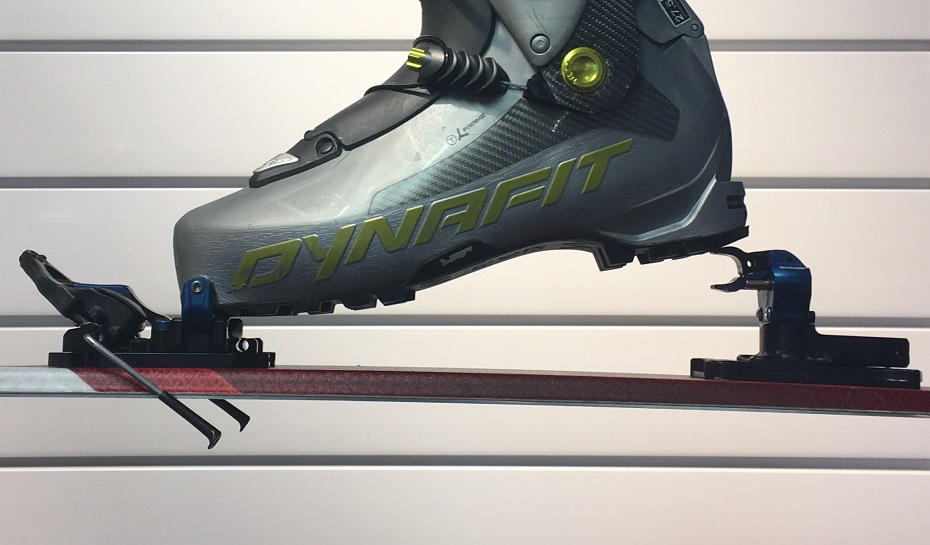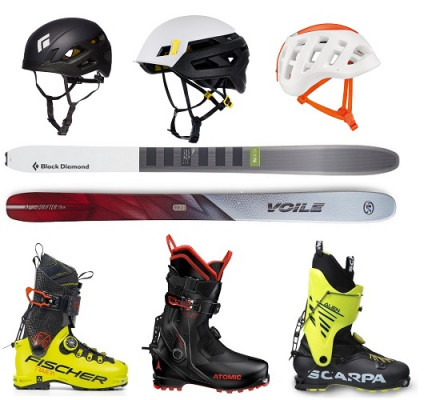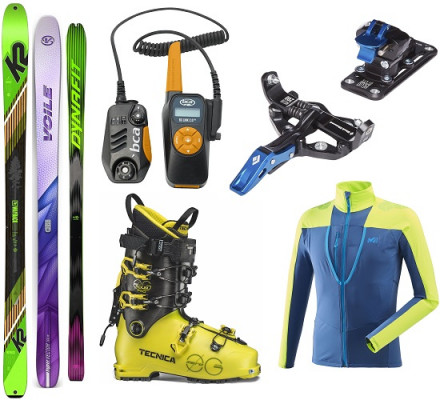11/6/2018 Binding Riser Heights
Go high or go low? Here are the numbers behind heel risers and efficient skinning.
Anyone who ski tours is familiar with the risers on binding heel pieces. From your first days on the skin track, people explain that they’re intended to make walking uphill easier. In theory—and in a few specific ways—they do, but that doesn’t necessarily mean you should go find the bindings with the highest heel risers. As is always the case in backcountry skiing decisions, the devil’s in the details. (But so is the energy-saving strategy.)

It’s complicated: how to crunch the numbers.
When we calculate your uphill efforts, we factor the weight of your skis, boots, skins, and even your pack into the calculation. On top of that, your skinning technique makes a big difference in deciding how much lift is best.
Let’s break it down. The reason you’d want a riser is to minimize leg strain—it reduces the need to flex your ankle all the way for each and every step. This adds up when you’re skinning—especially if the walk mode on your boots has significant resistance. Because when you have to use a lot of muscle power in your calves and shins to bend your ankle, you’ll have to take a shorter stride. This usually leads to cutting a steeper skin track to try to counter-balance your shorter reach with every step. You now get caught in a cycle—using higher heel lifters because you’re taking short steps on a steep skin track.
Things get worse from there: when you’re using high risers, it can lead to constant back-sliding, which just doesn’t help you land a second date with a new touring partner. Since high risers will shift your weight forward, you can feel like you’re walking on your tippy toes. Unfortunately, this means you lose a lot of the grip you would have had if the force of your weight were properly distributed behind your heels instead of your toes.
Most people compound the problem even more by then investing in the grippiest skins available—because they add even more friction beneath the ski. But this makes you want to lift your ski with every step, which is far less efficient than sliding it forward on the surface of the snow.
A better way: the sweet gospel of efficiency.
Even if you haven’t taken physics recently, it makes sense that sliding a weight up a hill is easier than lifting it to move it forward. (It’s called the ol’ mechanical advantage, which we wrote about in the context of slope angle.) But for this to be true, you need a low enough amount of friction between the surface you’re sliding on and the thing you’re sliding across it. To keep that friction sweet ‘n low, you probably need mohair or mixed mohair-synthetic skins, preferably with a glide treatment.
Now, it can all come together: if you have skins with a smooth glide, you cut them to less than full ski-base coverage, then pair them with boots that bend easily in walk mode. Add low heel risers, tech bindings, and a low-angled skin track, and you suddenly become an efficiency machine.
The difference is astounding—truly night and day. Master efficient skinning and pair that with the right gear, and you’re going to gain enough speed advantage to completely counteract the nacho platter you ate for après last week.
Riser heights, deltas, and what it means to you.
As incurable numbers people, we dug in and made a table to help you compare riser heights across alpine touring bindings. Below, in the first column, you’ll first see the riser heights above the surface of the ski, in millimeters. In the second column, you’ll see the approximate riser deltas—which is the distance of the riser above the toe pins. This is a key number to determine how much help you’ll be getting with every step.
Note, the first number in each column is a “flat” mode, if there is one. The lowest numbers come in handy on long, flat approaches. Negatives are best for downhill skinning.
| Binding | Riser Heights | Deltas |
| ATK Revolution | 0, 36 | -8, +28 |
| AKT Revolution Brake | 35 | +27 |
| ATK SL World Cup | 0, 35 | -9, +26 |
| ATK Trofeo | 0, 37.5, 42.5 | -9, +28.5, +33.5 |
| ATK Trofeo Brake | 35 | +26 |
| ATK Kuluar Superlite | 5.5, 43, 55 | -3.5, +34, +46 |
| ATK Kuluar | 16, 47.5, 60 | +7, +38.5, +51 |
| ATK Haute Route | 5.5, 43, 58 | -3.5, +34, +49 |
| ATK Haute Route Plus (2024+) | 5.5, 43.5, 44, 60.5, 64.5 | -7, +31, +31.5, +48, +52 |
| ATK Haute Route Plus (2023-) | 5.5, 42.5, 48.5, 56, 64 | -3.5, +33.5, +39.5, +47, +55 |
| ATK Hy | 16.5, 46.5, 73 | -15.5, +14.5, +41 |
| ATK Crest (2024+) | 21, 51, 71.5 | +8.5, +38.5, +59 |
| ATK Crest (2023-) | 16, 47, 60 | +7, +38, +51 |
| ATK Crest AP | 21, 51, 71.5 | +12, +42, +62.5 |
| ATK V-Crest | 16, 48, 48.5, 61.5, 67.5 | +3.5, +35.5, +36, +49, +55 |
| ATK RT 8/10 Evo | 22.5, 56.5, 72.5 | +13.5, +47.5, +63.5 |
| ATK RT 11 Evo | 22.5, 56.5, 72.5 | +9, +43, +59 |
| ATK [Free]Raider | 18, 49, 56, 63.5, 71 | +7.5, +38.5, +45.5, +53, +60.5 |
| ATK Raider SL | 21, 51.5, 73 | +8.5, +39, +60.5 |
| ATK Raider Evo | 21.5, 51, 72.5 | +9, +38.5, +60 |
| ATK Freeraider Evo | 21.5, 51, 72.5 | +5, +34.5, +56 |
| Atomic Backland Pure | 9.5, 53.5, 72.5 | 0, +44, +63 |
| Atomic Backland Brake | 25.5, 53.5, 72.5 | +16, +44, +63 |
| Atomic Summit | 12, 55.5, 76 | -0.5, +43, +63.5 |
| Atomic Summit Brake | 27.5, 55.5, 76 | +15, +43, +63.5 |
| BD Helio 110 | 0, 35 | -9, +26 |
| BD Helio 145 | 0, 37.5, 42.5 | -9, +28.5, +33.5 |
| BD Helio 180 | 5.5, 43, 48 | -3.5, +34, +39 |
| BD Helio 200 LT | 0, 36.5, 50 | -9, +27.5, +41 |
| BD Helio 200 | 5.5, 42, 55 | -3.5, +33, +46 |
| DPS R10 | 18.5, 48.5, 65 | +4.5, +34.5, +51 |
| DPS H10 | 22.5, 56.5, 72.5 | +9.5, +43.5, +59.5 |
| DPS R14 | 18, 49, 56, 63.5, 71 | +7.5, +38.5, +45.5, +53, +60.5 |
| Dynafit DNA/Mezzalama | 39.5 | +30.5 |
| Dynafit DNA+/Mezzalama+ | 41.5 | +32.5 |
| Dynafit Low Tech Race | 34 | +26.5 |
| Dynafit LTR 2.0 | 35 | +27.5 |
| Dynafit LTR 105 | 35 | +26 |
| Dynafit Radical ST/FT | 25.5, 59.5, 84 | +11, +45, +69.5 |
| Dynafit Radical 2.0/Rotation | 28, 61, 86.5 | +11, +44, +69.5 |
| Dynafit Ridge | 20.5, 55, 74 | +4, +38.5, +57.5 |
| Dynafit Seven Summits+ | 20.5, 63, 73 | +8, +50.5, +60.5 |
| Dynafit Blacklight | (12.5), 35, 53, 73 | (+3), +25.5, +43.5, +63.5 |
| Dynafit Blacklight+ | 35, 53, 73 | +25.5, +43.5, +63.5 |
| Dynafit Blacklight 2.0 / Pro | 15.5, 28, 56.5 | +2, +14.5, +43 |
| Dynafit Speed/SpeedFit | (13), 31, 45, 58 | (+3), +21, +35, +48 |
| Dynafit Speed Turn 1&2 | 12, 55, 88 | +4, +47, +80 |
| Dynafit Speed Radical | 12, 54, 77.5 | +4, +46, +69.5 |
| Dynafit Superlite 150 | 0, 30, 40.5, 51 | -9, +21, +31.5, +42 |
| Dynafit Superlite 2.0 / 175 | (0), 35, 50 | (-7.5), +27.5, +42.5 |
| Dynafit TLT Expedition | 37 | +29 |
| Fritschi Tecton | 29, 66.5, 89.5 | +8.5, +46, +69 |
| Fritschi Vipec Evo | 28.5, 63, 86 | +8.5, +43, +66 |
| Fritschi Xenic | 20, 64 | +8.5, +52.5 |
| G3 Zed 9 / 12 | 24, 56, 72 | +6, +38, +54 |
| G3 ION LT | 23, 60.5, 85.5 | +4, +41, +66 |
| G3 ION 10/12 | 27.5, 62, 87 | +8, +42.5, +67.5 |
| Grizzly GR98/Olympic | 0, 31.5 | -6.5, +25 |
| Hagan Ultra / ZR | 0, 35 | -9, +26 |
| Hagan Pure | 16, 47, 60 | +7, +38, +51 |
| Hagan Pin Up Evo | 22, 56, 72.5 | +13, +47, +63.5 |
| Hagan Ride | 9, 42, 55.5 | -1.5, +31.5, +45 |
| Hagan Boost | 18, 49, 56, 63.5, 71 | +5, +36, +43, +50.5, +58 |
| Hagan Core | 8.5, 47, 52, 60, 70 | -2.5, +36, +41, +49, +59 |
| Hagan Core Evo | 22, 50, 52.5, 68.5, 73 | +11.5, +39.5, +42, +58, +62.5 |
| Hagan Core Pro | 20, 48, 54, 66.5, 71 | +9.5, +37.5, +43.5, +56, +60.5 |
| Kreuzspitze SCTT | 0, 34 | -7.5, +27 |
| Kreuzspitze RS | 0, 34 | -8, +26.5 |
| Kreuzspitze GT | 0, 35 | -8, +27 |
| Kreuzspitze GT 2.0 | 0, 35.5, 51.5 | -8.5, +27, +43 |
| Kreuzspitze EL | 12, 40.5, 59.5 | +4, +32.5, +51.5 |
| Marker Alpinist | 12, 47.5, 55.5 | -1, +34.5, +42.5 |
| Marker Cruise | 23, 59, 76.5 | +10, +46, +63.5 |
| Plum Race 99 | 0, 32 | -9.5, +22.5 |
| Plum Race 120 | 0, 35 | -9, +26 |
| Plum Race 140 | 0, 36.5 | -9, +27.5 |
| Plum Race 150 | 0, 38 | -9.5, +28.5 |
| Plum Race 170 | 6.5, 41.5 | -3, +32 |
| Plum S170 | 6.5, 41.5 | -2.5, +32.5 |
| Plum Oazo | 6.5, 41, 54 | -3, +31.5, +44.5 |
| Plum Serak | 8, 41, 55.5 | -1.5, +31.5, +46 |
| Plum WEPA | 6.5, 53 | -3.5, +43 |
| Plum Pika | 16, 50.5 | +6.5, +41 |
| Plum Caribou / Summit 12 | 22, 58, 81.5 | +3, +39, +62.5 |
| Plum Karibou | 22, 57, 80.5 | +2.5, +37.5, +61 |
| Plum Guide | 8.5, 57.5, 82 | 0, +49, +73.5 |
| Plum Summit Stopper | 29, 60, 84 | +10, +41, +65 |
| Plum Yak | 22.5, 58, 82 | +4.5, +40, +64 |
| Plum Yak w/ Brakes | 24.5, 58, 82 | +6.5, +40, +64 |
| PG U77 | 40 | +32.5 |
| Salomon MTN Pure | 9.5, 53.5, 72.5 | 0, +44, +63 |
| Salomon MTN Brake | 25.5, 53.5, 72.5 | +16, +44, +63 |
| Salomon Summit | 12, 55.5, 76 | -0.5, +43, +63.5 |
| Salomon Summit Brake | 27.5, 55.5, 76 | +15, +43, +63.5 |
| Ski Trab Gara Titan | 0, 35 | -10, +25 |
| Ski Trab Titan Brake | 35 | +25 |
| Ski Trab Titan Vario 1 / LT | 0, 39 | -10, +29 |
| Ski Trab Vario LT Adjustable | 5.5, 44.5 | -9, +30 |
| Ski Trab Titan Adjustable | 8.5, 47.5 | -5.5, +33 |
| Ski Trab Titan Vario.2 | 8.5, 51, 59 | -5.5, +36.5, +44.5 |
| Ski Trab TR-2 | 42, 65 | +27, +50 |
| Slatnar ST Touring | 17, 51.5, 65.5 | +8.5, +43, +57 |
| Tyrolia Almonte | 17.5, 52.5, 72.5 | +7, +42, +62 |
(Parenthesis indicate unofficial riser height with no detent)
It’s worth noting that each delta was adjusted by 21mm to account for the average height of tech-heel sockets above the ground. (The rubber sole of your boot is what contacts the risers, but your foot sits above that inside your boot.) Your boot might be a bit different, and sole-rocker is yet another variable—but the table gives you a good starting-point to visualize. The delta can be thought of as how much higher you heels are above your toes as compared to standing on flat ground in a flat boot. This is the skinning equivalent of the skiing pin-heights which we previously documented.

The takeaway?
Now that you’ve wrapped your head around your heel risers’ role, keep in mind that there are several other things you can do to make skinning much easier and more efficient.
First, always set a low-angled skin track. The guy who sets the steep one isn’t tougher—he’s just blissfully unaware of physics. But before you judge, it's also possible he has limited range of motion in his ankles due to injury, in which case being stuck with high-pegs is a sad reality.
Then, pick the right skins and cut ‘em to the right width for efficiency. This is especially critical for skiers with heavier gear, who would benefit most from sliding their gear weight uphill rather than lifting it. But sadly, those people often carpet their planks with a wide, thick shag that nixes the benefits of an inclined plane. For wide skis on powder days, you don’t need wall-to-wall carpeting. And on firm days, you don’t need wide skis. So cut those skins a little narrower than you might think, and you’ll get the right amount of grip with the least amount of drag.
And, any day of the year, you’ll only achieve skinning nirvana with boots that articulate freely. So do yourself a favor and choose boots with an excellent range so you’re not straining against the shell and liner with every step.
Get all that right, and the high-heel-riser vs low-heel-riser question will probably fade from prominence. You’ll be moving too swiftly to care.
Comments
I compared it with the Kreuzspitze. The Dynafit version "+" with brakes had a riser height of 6mm more than the Kreuzspitze SCTT, which is 1mm lower than the basic dynafit 105 without brake.
Am I thinking correctly?
Thanks for the advice.

10/1/2019
2019/20 Season Preview









